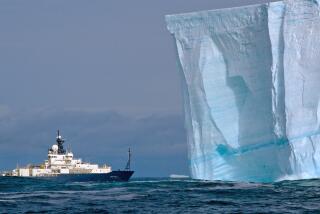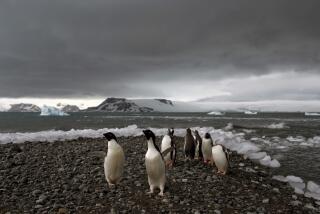Antarctica Drawing in the Adventurous
- Share via
PALMER STATION, Antarctica — For centuries a tantalizing but inaccessible wilderness, Antarctica is becoming a magnet for wealthy and adventurous tourists.
Drawn by breathtaking scenery--and the chance to set foot where few others have--they come in cruise ships, aircraft and even tiny yachts.
The unregulated rise in tourism is worrying those who see the continent as a unique natural laboratory which holds the key to our world’s past--and possibly future--climate.
“Antarctica, from a scientific point of view, is a critical part of the planet,” William Fraser, an expert in Antarctic sea birds, told a visitor at this U.S. research base.
“There has to be a limit (to tourism),” he said.
The recent crash of a Chilean airliner, which killed 20 tourists on their way to an Antarctic cruise, highlighted one of the worries--that the more tourists who visit, the greater the risk of a serious accident in a remote area.
Regular commercial flights to Antarctica were suspended after eight American tourists died when their small plane crashed into a glacier at a Chilean air base in 1986.
In 1979 an Air New Zealand flight crashed near McMurdo killing all 257 on board.
The sea is also treacherous. In 1989 the Argentine ship Bahia Paraiso sank here. Its crew and 81 tourists survived, but 170,000 gallons of fuel poured out, fouling the ocean and bird breeding sites.
Adventurers on non-governmental expeditions, classed as tourists under the Antarctic Treaty, also cause problems.
A private expedition retracing Robert F. Scott’s ill-fated 1912 British polar journey arrived at the South Pole in 1985 to be told that their supply ship had been crushed by ice and sunk.
It is easy to understand the attraction of Antarctica for tourists bored with crowded beaches or historic buildings.
Ships glide past spectacular walls of ice as seals and whales surface alongside. They stop at islands where thousands of penguins and sea birds breed.
Tourists first flew to the Antarctic in 1956 and cruises began in 1958. But in the last few years tourism has exploded.
Under a 30-year-old treaty, Antarctica is maintained as a peaceful scientific enclave by 39 signatory nations. But U.S. officials say that during this January and February, the peak visiting time, more tourists came than ever before.
Twelve tour ships stopped at Palmer in January and February and more than 1,500 people visited--50% more than two years ago.
While the small number of tour operators now working in the area do take care, scientists say, with no rules on who can run Antarctic tours, others may not be so careful.
Even without accidents, tourism can hurt the finely balanced ecosystem. Birds can be frightened away from long-term breeding sites. Merely stepping on fragile moss and lichens may cause damage that the plants will not repair for decades.
All tourism does not necessarily have to bad, however.
Some people also question scientists’ right to preach about the dangers of tourism when environmental groups say research bases are currently the biggest polluters of Antarctica.
“There is not one person in Antarctica who isn’t a tourist. No one is a permanent resident,” said Deborah Shapiro, an American who plans to spend the winter in the Antarctic with her Swedish husband, Rolf Bjelke, on board their specially built yacht. Both are experienced polar sailors.
However, Shapiro, scientists and environmentalists all agree on the need for Antarctic tourism to be regulated before it is too late.
Ironically, it may be the tourists who persuade governments now squabbling over whether to ban mining in the Antarctic of the need to protect the world’s last wilderness.
“The only way we’re going to do anything about (Antarctica) is if people have a stake in it,” Fraser said. “The only way they can have a stake is if they come, see, understand and be ready to defend it.”
More to Read
Sign up for Essential California
The most important California stories and recommendations in your inbox every morning.
You may occasionally receive promotional content from the Los Angeles Times.










